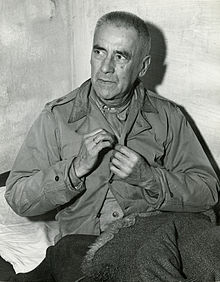Wilhelm Frick
Wilhelm Frick (12 March 1877 – 16 October 1946) was a convicted war criminal and prominent German politician of the Nazi Party (NSDAP) who served as Minister of the Interior in Adolf Hitler's cabinet from 1933 to 1943[3] and as the last governor of the Protectorate of Bohemia and Moravia.
As the head of the Kriminalpolizei (criminal police) in Munich, Frick took part in Hitler's failed Beer Hall Putsch of 1923, for which he was convicted of high treason.
Born in the Palatinate municipality of Alsenz, then part of the Kingdom of Bavaria, Germany, the last of four children of Protestant teacher Wilhelm Frick sen. (d. 1918) and his wife Henriette (née Schmidt).
Chief of Police Ernst Pöhner introduced him to Adolf Hitler, whom he helped willingly with obtaining permission to hold political rallies and demonstrations.
Elevated to the rank of an Oberamtmann and head of the Political department of the Munich police from 1923, he and Pöhner participated in Hitler's failed Beer Hall Putsch on 9 November.
Frick tried to suppress the State Police's operation, wherefore he was arrested and imprisoned, and tried for aiding and abetting high treason by the People's Court in April 1924.
He associated himself with the radical Gregor Strasser; making his name by aggressive anti-democratic and antisemitic Reichstag speeches, he climbed to the post of the Nazi parliamentary group leader (Fraktionsführer) in 1928.
On 23 January 1930, Frick was appointed to these ministries, becoming the first Nazi to hold a ministerial-level post at any level in Germany (though he remained a member of the Reichstag).
[8] Frick used his position to dismiss Communist and Social Democratic officials and replace them with Nazi Party members, so Thuringia's federal subsidies were temporarily suspended by Reich Minister Carl Severing.
When Reich president Paul von Hindenburg appointed Hitler chancellor on 30 January 1933, Frick joined his government as Reichsminister of the Interior.
Though Frick held a key position, especially in organizing the federal elections of March 1933, he initially had far less power than his counterparts in the rest of Europe.
Indeed, the main reason that Hindenburg and Franz von Papen agreed to give the Interior Ministry to the Nazis was that it was almost powerless at the time.
[7] Already in July 1933, he had implemented the Law for the Prevention of Hereditarily Diseased Offspring including forced sterilizations, which later culminated in the killings of the Action T4 "euthanasia" programme supported by his ministry.
In the summer of 1938 Frick was named the patron (Schirmherr) of the Deutsches Turn- und Sportfest in Breslau, a patriotic sports festival attended by Hitler and much of the Nazi leadership.
From the mid-to-late 1930s Frick lost favour irreversibly within the Nazi Party after a power struggle involving attempts to resolve the lack of coordination within the Reich government.
Its capital Prague, where Frick used ruthless methods to counter dissent, was one of the last Axis-held cities to fall at the end of World War II in Europe.
Of his execution, journalist Joseph Kingsbury-Smith wrote:The sixth man to leave his prison cell and walk with handcuffed wrists to the death house was 69-year-old Wilhelm Frick.
[20]His body, along with those of the other nine executed men and the corpse of Hermann Göring, was cremated at the Ostfriedhof Cemetery in Munich, and the ashes were scattered in the river Isar.




